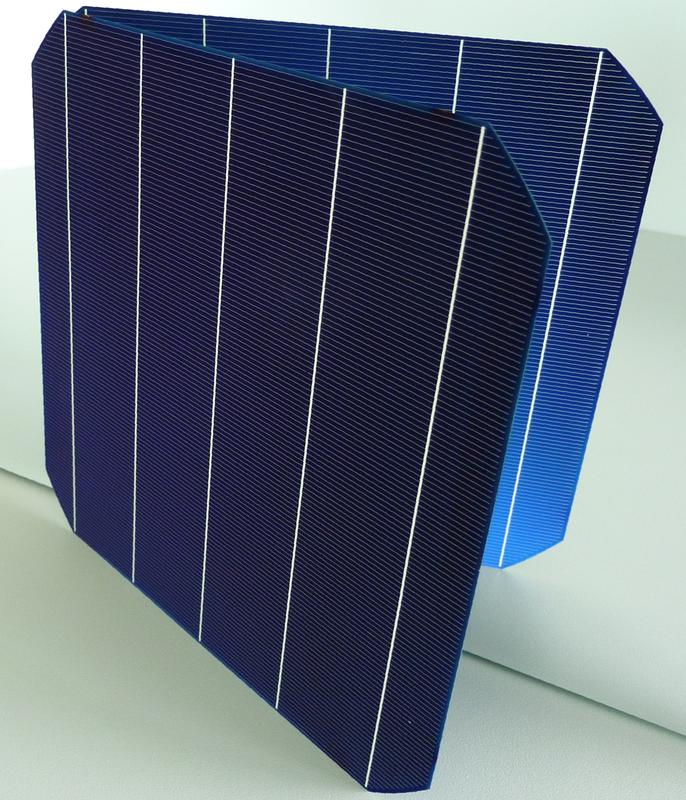Ion implanted, co-annealed, screen-printed 21% efficient n-PERT solar cells with a bifaciality >97%

Photograph of a 156 mm × 156 mm large, ion implanted, co-annealed and fully screen-printed bifacial n-type PERT solar cell with an efficiency of 21 %. Till Brendemühl/ISFH
The Institute for Solar Energy Research Hamelin (ISFH) and the Institute for Electronic Materials and Devices (MBE) of the Leibniz University Hannover have successfully completed the joint-development project “CHIP” on industrial ion implanted n-type PERT (Passivated Emitter and Rear, rear Totally doped) solar cells.
The CHIP (Cost-efficient High-throughput Ion implantation for Photovoltaics) project was funded by the German Federal Ministry for Economic Affairs and Energy. In CHIP, the driving mechanisms for the annealing of implant damage have been investigated scientifically with special attention on non-amorphizing boron and amorphizing BFx implants.
The latter are highly relevant for the transfer of ion implantation into photovoltaics since PV implanters generally do not feature mass separators and therefore mainly implant BF2 rather than elementary boron.
The obtained insights into the annealing processes have been applied for processing of industrial n-type PERT cells within a very lean process flow: After double-side texturing of 156mm×156mm large n-type Cz wafers, the front-side was boron or BF2 implanted, and the rear-side was implanted with phosphorous.
Implant damage was annealed in a single high-temperature step (co-annealing), while the utilization of BF2 enabled a significant reduction of required temperature. After annealing, the front-side was passivated by an Al2O3/SiNx stack, and the rear side was passivated by SiNx. Subsequently, screen-print at the front and the rear and co-firing was performed. Silver consumption was minimized utilizing fine-line print.
The highest, independently confirmed efficiency of a cell with a boron implanted emitter, measured on a brass chuck, was 21.0% where Voc was 664.6 mV, Jsc was 39.8 mA/cm2, and FF was 79.3%. In-house measurements from front and rear side yielded a bifaciality factor of 97.3%.
The highest, independently confirmed efficiency of a cell with a BF2 implanted emitter, also measured on a brass chuck, was 20.6% where Voc was 657.6 mV, Jsc was 39.9 mA/cm2, and FF was 78.4%. In-house measurements from front and rear side yielded a bifaciality factor of 97.7%.
According to Dr. Robby Peibst, head of the project, the results show that ion implantation is an enabling and economical doping technology, and screen-print on n-type cells undergoes an evolutionary improvement comparable to that on p-type cells. The lean process flow, the high efficiency without LID and the high bifaciality makes n-type PERT a viable cell concept.
Media Contact
All latest news from the category: Power and Electrical Engineering
This topic covers issues related to energy generation, conversion, transportation and consumption and how the industry is addressing the challenge of energy efficiency in general.
innovations-report provides in-depth and informative reports and articles on subjects ranging from wind energy, fuel cell technology, solar energy, geothermal energy, petroleum, gas, nuclear engineering, alternative energy and energy efficiency to fusion, hydrogen and superconductor technologies.
Newest articles

Silicon Carbide Innovation Alliance to drive industrial-scale semiconductor work
Known for its ability to withstand extreme environments and high voltages, silicon carbide (SiC) is a semiconducting material made up of silicon and carbon atoms arranged into crystals that is…

New SPECT/CT technique shows impressive biomarker identification
…offers increased access for prostate cancer patients. A novel SPECT/CT acquisition method can accurately detect radiopharmaceutical biodistribution in a convenient manner for prostate cancer patients, opening the door for more…

How 3D printers can give robots a soft touch
Soft skin coverings and touch sensors have emerged as a promising feature for robots that are both safer and more intuitive for human interaction, but they are expensive and difficult…





















